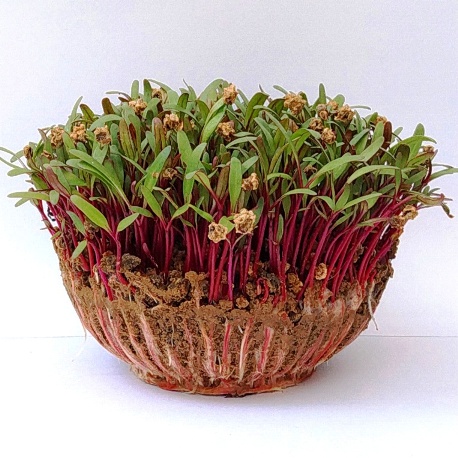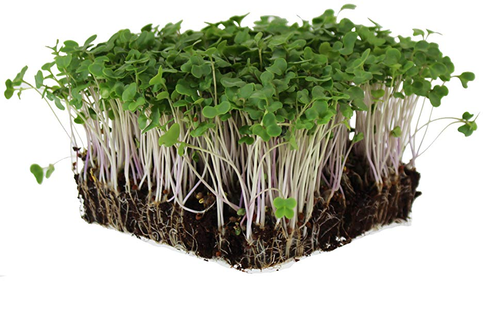वेजिटेबल माइक्रोग्रीन्स: भविष्य के लिए एक सुपरफूड
The main lifestyle-related issues, such as diseases and nutritional deficiencies, have resulted from the increased quality of living in terms of social, economic, and cultural norms. In the future, a major issue will be the lack of fresh, pesticide-free vegetables. Long food chains that start in far-flung rural regions restrict the availability of products with a limited shelf life and inadequate transportation capacity for urban people.
As a consequence, many urban residents live in so-called "food deserts," where they lack easy access to fresh agricultural goods such as fruits and vegetables, as well as a full package of necessary nutrients, and must rely on processed and packaged meals instead. Globally, there is a huge need for functional food due to increased health awareness and lifestyle changes.
Microgreens are referred to as 'practical nourishments,' which are foods that have specific health-promoting and infection-prevention characteristics in addition to their usual health advantages. In the human diet, they are also referred as as a good source of minerals. Microgreens are a new food category that can help with almost any medical problem linked to a lack of nutrition. Microgreens' culinary worth has risen dramatically in recent decades as a result of its high nutritional content, flexibility, taste profile, and crisp texture.
Vegetable Microgreens
Microgreens are immature, tiny sprouts of vegetables and herbs picked when the cotyledons (seed leaves) have completely grown and the first pair of genuine leaves have emerged or are partly extended. These microgreens grow to a height of 1-3 inches (2.5–7.6 cm) within 7–14 days after germination, depending on the crop, variety, and other environmental factors.
A central stem, two cotyledon leaves, and usually the first pair of very immature true leaves are the three fundamental components. Spinach, mustard, buckwheat, arugula, celery, cilantro, amaranth, golden pea, basil, spinach, mizuna, pepper cress, popcorn shoots, red mustard, red beet (Fig 1), red cabbage, red orach, sorrel, red sorrel, wasabi, cabbage, broccoli (Fig 2), radish, lettuce, kale, rapini, and other microgreens are commonly cultivated.
With the assistance of scissors, microgreens are cut together with the stem and connected cotyledons/ seed leaves. They will quickly elongate and lose colour and taste if kept for an extended period of time. It differs from sprouts in that sprouts are germinated seeds that are eaten together with the embryonic root and seeds.
Microgreens are considerably smaller than baby greens and are smaller than baby greens. Their state is somewhere in the between of sprouting and baby greens. Vegetable confetti is another name for it.
Nutritional importance of vegetable microgreens
Microgreens are greater in a variety of micronutrients, including vitamins and minerals. Microgreens contain more nutrients than their mature counterparts. Vitamin A, C, E, K, enzymes, and carotenoid content varies depending on the kind of microgreens, growth medium, quantity of sunshine and temperature, and harvesting period.
Microgreens with bright colours are shown to be more nutritious than those with light colours. In contrast to sprouts, microgreens contain more a-carotene, -carotene, violaxanthin, lutein, and neoxanthin. They are higher in protein, iron, and zinc than sprouts. Antinutritional factors like nitrate (NO3-) and nitrite (NO2-) concentration are also extremely low in microgreens, which is interesting to know.
Fig 1. Beetroot microgreens Fig 2. Broccoli microgreens
Growing of vegetable microgreens
The first decision a microgreens grower must make is whether to grow their crop indoors or outdoors. According to my growing expertise with microgreens, an indoor setup is a better option since it allows for greater control over the developing environment.
Microgreens thrive best in the same temperature range, so a farmer may simply produce their greens in any spare space in their house or garage by establishing a perfect and regulated environment. Outdoor installations offer their own set of advantages and disadvantages.
Growing microgreens outdoors has the benefit of not requiring an artificial light source, but it does require the proper environmental conditions. Growing microgreens outside has a number of disadvantages. Due to the risk of severe temperature changes and frost, growing microgreens without supplementary heat is not feasible outside of this time period.
A greenhouse may be a better choice for growing microgreens outside, but it may be extremely costly for a farmer.
Growing medium
Microgreens may be cultivated in a variety of media, including soil, tissue paper, and hydroponics. In general, a 5:2:1 ratio of Coco-peat, vermiculite, and perlite may be utilised to produce microgreens. Because the release of macro- and micronutrients in this medium is extremely gradual, a farmer may use the same media for the development of their young greens many times.
Microgreens seeds do not need additional nourishment for germination; instead, they just require perfect circumstances (environmental and appropriate water moisture conditions for imbibitions) for germination up to the microgreen stage, making microgreen production simple and cost-effective.
Seeds that have been treated with different chemicals are not appropriate for microgreen farming, and hybrid seeds may not be cost-effective for you.
Sowing microgreens
Seeds might well be planted at any time of year to meet the needs of the customer. The roots and other residual components of previous crops should be completely removed from the trays/container during the reuse of prior sowing medium. Fill the trays/container with the media once it has been thoroughly dried by exposing it to sunshine.
To keep your greens at the ideal temperature, humidity, and light intensity, you may utilise any living space, such as rooms or a mini-greenhouse. Microgreens cultivated in a high-light environment with low humidity and excellent air movement will provide a superior crop.
Harvesting and Post harvest handling of microgreens
Microgreens could well be harvested 7–14 days after germination in tropical climates and somewhat longer (14–28 days) in temperate climates, depending on the crop and other climatic factors. Scissors may be used to cut microgreens, including the stem and connected seed leaves.
Microgreens have a limited shelf life and need improved storage and transportation methods. Microgreens for business are often stored in plastic clamshell containers. There are other sustainable clamshell containers on the market.
Microgreens as growing business
People all around the globe are increasingly realising the advantages of including leafy greens and microgreens into their diets, guaranteeing that demand continues to rise. Furthermore, we are witnessing an increase in the number of issues and crop failures of vegetables produced outside, indicating that agriculture has an indoor future.
- Farmers may start their company with a little investment by providing one restaurant with greens or growing enough microgreens to sell once a week at a farmer's market, then scaling up production as demand grows.
- Microgreens have a quick turnaround time of 7-14 days from seed to harvest. Harvesting does not have to take place over the course of a season or longer.
- Microgreens may be produced all year, and a farmer can utilise them to supplement their income and diversify their company for more profit.
- Microgreens are ‘functional foods,' which means they provide more nutrients. They include a wide range of vitamins and minerals.
- A farmer would sell their microgreens to rising restaurants and grocery shops for greater rates, and as a local grower, they can also charge a premium. Contains a wide range of vitamins and minerals.
Conclusion
Microgreens are tiny green leafy vegetables that may be harvested in 7-14 days, including the stem and leaves. They have a beautiful look, a soft texture, and a strong taste, and they provide a complete nutritional package. Microgreens have a higher nutritional content than their adult counterparts.
Microgreens have a high market acceptance when it comes to taste acceptability. Consistency and quality may be maintained by exposing them to low temperatures with modified atmospheric packing.
References
- Kopsell, Dean A. "Increases in Shoot Tissue Pigments, Glucosinolates, and Mineral Elements in Sprouting Broccoli after Exposure to Short-duration Blue Light from Light Emitting Diodes". Journal of the American Society for Horticultural Science.
- Taylor, K. 2018. Commercial Microgreens: Production and Best Practices" www.agric.gov.ab.ca.
Authors:
Raman Selvakumar1, Praveen Kumar Singh1, Gangadhara K2, Manjunathagowda D.C3, Jugendra Kumar1
1ICAR-Indian Agricultural Research Institute, Pusa Campus, New Delhi, India
2 ICAR-Central Institute of Arid Horticulture, Central Horticultural Experimental Station, Gujarat
3ICAR-Directorate of Onion and Garlic Research, Pune, Maharashtra, India
Corresponding email:



